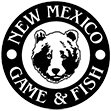New Mexico Department of Game and Fish |
FOR IMMEDIATE RELEASE, April 1, 2009: |
GET READY FOR ANOTHER GREAT FISHING SEASON AT NORTHWESTERN NEW MEXICO LAKES, STREAMS By Rick Castell Fishing in New Mexico is good year-round depending where you cast a line, but the season "officially" opens April 1, the day anglers must purchase a new fishing license. Once that formality is out of the way, the opportunities are nearly endless, whether you are after trout, bass or any of the state's wide range of sport fish. But the question remains: Where to go? Fortunately, the Department of Game and Fish has fisheries biologists willing to stick their necks out and advise anglers about the best waters for the type of fishing they prefer. Here's my forecast for northwestern waters: Navajo Lake -- always a good bet Navajo Lake completely filled last year and it should maintain a significant water level this year. This should translate to adequate spawning opportunity for game fish this spring.
Abiquiu Lake -- pretty steady
Ramah Lake -- Go early in the season Ramah is still recovering its spiny-ray population following an extensive fish-kill in 2006. Spring surveys should determine whether any largemouth bass survived. Depending upon the runoff, Ramah will rise, probably quite a bit this year. However, the higher water levels have been short-lived in recent years. In fact, during the last two years, we were only able to stock rainbow trout in early to mid-spring. The same thing likely will happen this year, but quite a few trout are usually stocked during this period of time. It’s definitely worth the trip for the scenery, if nothing else.
Jemez-area streams -- a safe bet A Santa Fe National Forest map will help you find good fishing opportunities in the Rio Cebolla, Rio Las Vacas, Jemez River main and east forks, and the Guadalupe River. Water levels should be good most of the year, and most all of the Jemez-area streams are stocked regularly with catchable rainbow trout (March to September). Most of these streams also contain brown trout, and the fishing should be good, especially in the fall as the browns go to spawn. San Pedro Parks Wilderness streams -- my favorite High mountain streams such as the Rio Perchas, Rio Las Vacas and Rio Puerco are always a good bet for Rio Grande Cutthroat trout. If you’re willing to take a hike into the woods, you will be rewarded. This area is one of the most beautiful in the state, and you usually won’t see another person. Don't forget your Santa Fe National Forest map. The Rio Las Vacas will provide the most opportunity for the avid fly fisherman, as it’s by far the most voluminous of these streams and provides the most room for casting. The best bet is usually to hike up the Palomas trail until it bisects the Rio Las Vacas. From there you can travel up or down stream. San Juan River -- a blue-ribbon fishery The San Juan flows from below Navajo Dam and back into Colorado northwest of Shiprock. Fishing should be good, as it usually is, for most of the year. This is especially true following the runoff and releases from Navajo Lake when water flows are reduced to less than 500 cubic feet per second. The San Juan is regularly stocked with catchable-size rainbow trout below the four-mile stretch of special regulation "quality" waters below the dam. Brown trout also are prevalent throughout the length of the San Juan. The San Juan provides opportunities for everyone from the most avid and purist fly angler to the novice beginner. The first quarter-mile below the dam is catch-and-release only, with tackle restricted to artificial flies or lures only, and no more than two single barbless hooks per line. The same tackle restrictions apply to the next 3.5 miles downstream, although anglers are allowed to keep one fish per day at least 20 inches long. A number of capable guides are available in the Navajo Dam area for beginners or those who want to learn the river. Look for fishing forecasts for other areas of New Mexico in the 2009-2010 Fishing Rules & Information booklet, available at license vendors statewide, Department of Game and Fish offices in Santa Fe, Albuquerque, Raton, Roswell and Las Cruces; and online at www.wildlife.state.nm.us. Rick Castell is the Northwest Area fisheries biologist for the New Mexico Department of Game and Fish. He can be reached in Albuquerque at (505) 222-4715 or rick.castell@state.nm.us. ### |


